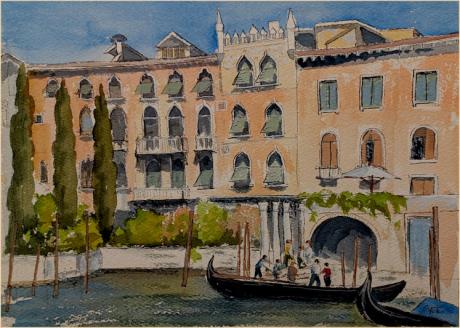" P Yates" and inscribed on the reverse
Unframed
The famous Grand Canal of Venice is 2.5 miles long and takes the course of an ancient river bed. During the Republic anyone who was anyone had to have a palace (palazzo) facing this glorious stretch of water. There was always limited space to build in Venice but there are approximately 200 buildings lining the two sides of the canal.Many of the palazzi still bear the surname of the patrician families who made their fortunes and wanted to demonstrate it to all.The names read like a list of Venice’s oldest and most important families. They include the Contarini, Dandolo, Michiel, Falier, Tiepolo, Badoer, Zen, Corner and Morosini and are a core of around thirty surnames forming the elite of the old Republic. They still impress today, but when you consider the difficulties of living in the lagoon it was not surprising that many lost interest and transferred their real estate interests to the mainland. What is fascinating is that all have wonderful stories to tell and remain architectural marvels.The buildings were not just luxurious homes but also offices, function rooms and hideaways. Many were even rented out to the Serenissima to host royalty and important visitors such as the Fondaco dei Turchi.
This was built in the 13th century as a luxurious residence for the Pesaro family. It was so plush it was often used to guest royalty.It had a series of owners before being rented from the Republic by the Turkish community, as much to keep an eye on them as to offer them a base for trade and warehousing. Here are other Grand Canal Palaces which caught our eye in no special order.
Palazzo Ca’ Pesaro was completed by the end of the 17th century and is a fine example of Venetian Baroque architecture. Today it is a gallery of modern art. This artwork was, in the main, bought by the Venice municipality during the many Biennale Art exhibitions of the 20th century. A second floor is dedicated to Oriental art. Before its construction the Pesaro family actually used to live in a 14th century Palazzo which is today home to the Fortuny Museum. It had been a music college before its purchase by Spanish artist Mariano Fortuny Y Madrazo. She eventually left it to the Comune of Venezia.
Palazzo Flangini seems a little truncated or narrow as if half of it is missing. In fact, the building used to be twice the size. There are a number of theories as to why.The first seems to rest on the consequences of an economic down during its construction. The funds dried up and the project subsequently redimensioned. This may have been due to the loss of a cargo or failure of a similar commercial enterprise which was not uncommon. The truth, however, might be more colourful and improbable. Some say that exactly one half of the building was demolished in spite after it was inherited by two brothers of the Flangini family who could not see eye to eye. Palazzo Grassi was built for the Grassi family who were originally from Chioggia. It is recognized as one of the finest of all the noble Venetian palaces and a symbol of the Grand Canal.
Today, it houses many of the city's best temporary exhibitions, but it is a building with many hidden entrances and passageways for illicit meetings. Before being sold to the National Portrait Gallery of London in 1870, Palazzo Pisani Moretta had the honour of being home to what is widely regarded as artist Paolo Veronese’s finest work: ‘La Famiglia di Dario ai Piedi di Alessandro’.
The last male heir to the noble house, Count Vettore Pisani, needed the cash and the sum he received was divided equally and presented over dinner in three finger bowls each containing five thousand gold coins. Palazzo Grimani faces, on the opposite bank of the Grand Canal, Palazzo Papadopoli of the Tiepolo family. The two became historically linked when the son of the Grimani, and future father of the Doge Grimani, asked for the hand in marriage of the daughter of the Tiepolo. His approach was rebuffed as the young Grimani had not yet constructed his own palace on the Grand Canal, so Palazzo Grimani was built.
Palazzo Balbi (main image above) was built by Nicolò Balbi. Before he made his riches he lived in rented accommodation.One month, when he had forgotten to pay, the landlord could not help himself and embarrassed the young man him in public, a terrible insult to a noble. Balbi immediately paid up and moved out. He then purchased a boat and moored it outside of the home of his ex landlord blocking the light and the view of the canal. Today, Palazzo Balbo is home to the Regione Veneto and it was from here Napoleon observed a regatta in his honour in 1807.
Palazzo Contarini delle Figure takes its name from a statue above its canal side entrance. It is a figuration of a man and woman both ripping their hair out. The man was a compulsive gambler and the work immortalizes the moment when both husband and wife realised he had lost the last thing he was able to bet on, his wife.Also note that the pediment spanning the central windows of the 'piano nobile' is a very unusual feature in Venetian palaces. Palazzo Ca’Vendramin Calergi Composer Richard Wagner died here in 1883. Today the palazzo is home of the Municipal Venice Casino, one of many established when it seemed the inhabitants and nobles of the city did nothing else but gamble during their leisure time.

